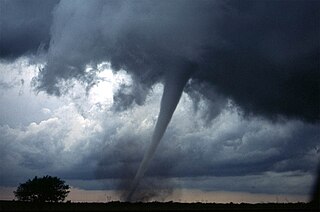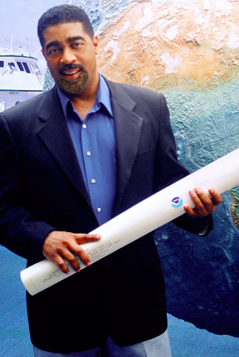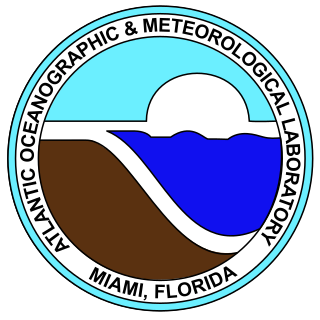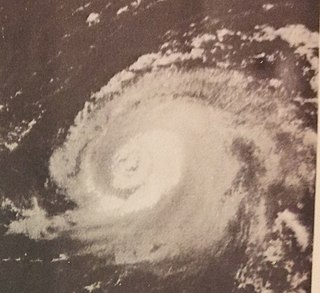
The National Oceanic and Atmospheric Administration is a US scientific and regulatory agency charged with forecasting weather, monitoring oceanic and atmospheric conditions, charting the seas, conducting deep-sea exploration, and managing fishing and protection of marine mammals and endangered species in the US exclusive economic zone. The agency is part of the United States Department of Commerce and is headquartered in Silver Spring, Maryland.

The National Hurricane Center (NHC) is the division of the United States' NOAA/National Weather Service responsible for tracking and predicting tropical weather systems between the Prime Meridian and the 140th meridian west poleward to the 30th parallel north in the northeast Pacific Ocean and the 31st parallel north in the northern Atlantic Ocean. The agency, which is co-located with the Miami branch of the National Weather Service, is situated on the campus of Florida International University in University Park, Miami, Florida.

Weather modification is the act of intentionally manipulating or altering the weather. The most common form of weather modification is cloud seeding, which increases rainfall or snowfall, usually for the purpose of increasing the local water supply. Weather modification can also have the goal of preventing damaging weather, such as hail or hurricanes, from occurring; or of provoking damaging weather against an enemy, as a tactic of military or economic warfare like Operation Popeye, where clouds were seeded to prolong the monsoon in Vietnam. Weather modification in warfare has been banned by the United Nations under the Environmental Modification Convention.

Project Stormfury was an attempt to weaken tropical cyclones by flying aircraft into them and seeding with silver iodide. The project was run by the United States Government from 1962 to 1983. The hypothesis was that the silver iodide would cause supercooled water in the storm to freeze, disrupting the inner structure of the hurricane, and this led to seeding several Atlantic hurricanes. However, it was later shown that this hypothesis was incorrect. It was determined that most hurricanes do not contain enough supercooled water for cloud seeding to be effective. Additionally, researchers found that unseeded hurricanes often undergo the same structural changes that were expected from seeded hurricanes. This finding called Stormfury's successes into question, as the changes reported now had a natural explanation.

Evan B. Forde is an American oceanographer at the Atlantic Oceanographic & Meteorological Laboratory (AOML) with the National Oceanic & Atmospheric Administration (NOAA). He was the first African-American scientist to perform research in a submersible. Forde is widely considered an expert on the formation of submarine canyons and his recent research uses satellite sensors to analyze atmospheric conditions related to hurricane formation.

The Weather Prediction Center (WPC), located in College Park, Maryland, is one of nine service centers under the umbrella of the National Centers for Environmental Prediction (NCEP), a part of the National Weather Service (NWS), which in turn is part of the National Oceanic and Atmospheric Administration (NOAA) of the U.S. Government. Until March 5, 2013 the Weather Prediction Center was known as the Hydrometeorological Prediction Center (HPC). The Weather Prediction Center serves as a center for quantitative precipitation forecasting, medium range forecasting, and the interpretation of numerical weather prediction computer models.
This is a list of meteorology topics. The terms relate to meteorology, the interdisciplinary scientific study of the atmosphere that focuses on weather processes and forecasting.

The Atlantic Oceanographic and Meteorological Laboratory (AOML), a federal research laboratory, is part of the National Oceanic and Atmospheric Administration's (NOAA) Office of Oceanic and Atmospheric Research (OAR), located in Miami in the United States. AOML's research spans tropical cyclone and hurricanes, coastal ecosystems, oceans and human health, climate studies, global carbon systems, and ocean observations. It is one of seven NOAA Research Laboratories (RLs).
The National Severe Storms Laboratory (NSSL) is a National Oceanic and Atmospheric Administration (NOAA) weather research laboratory under the Office of Oceanic and Atmospheric Research. It is one of seven NOAA Research Laboratories (RLs).

The Atlantic hurricane season is the period in a year, from June 1 through November 30, when tropical or subtropical cyclones are most likely to form in the North Atlantic Ocean. These dates, adopted by convention, encompass the period in each year when most tropical cyclogenesis occurs in the basin. Even so, subtropical or tropical cyclogenesis is possible at any time of the year, and often does occur.

James Louis Franklin is a former weather forecaster encompassing a 35-year career with National Oceanic and Atmospheric Administration (NOAA). He served as the first branch chief of the newly formed Hurricane Specialist Unit (HSU) before his retirement in 2017.

Christopher William "Chris" Landsea is an American meteorologist, formerly a research meteorologist with the Hurricane Research Division of the Atlantic Oceanographic and Meteorological Laboratory at NOAA, and now the Science and Operations Officer at the National Hurricane Center. He is a member of the American Geophysical Union and the American Meteorological Society.

Robert H. Simpson was an American meteorologist, hurricane specialist, first director of the National Hurricane Research Project (NHRP) from 1955 to 1959, and a former director (1967–1974) of the National Hurricane Center (NHC). He was the co-developer of the Saffir–Simpson Hurricane Scale with Herbert Saffir. His wife was Joanne Simpson.

Hurricane Gladys was the farthest tropical cyclone from the United States to be observed by radar in the Atlantic basin since Hurricane Carla in 1961. The seventh named storm and fifth hurricane of the 1975 Atlantic hurricane season, Gladys developed from a tropical wave while several hundred miles southwest of Cape Verde on September 22. Initially, the tropical depression failed to strengthen significantly, but due to warm sea surface temperatures and low wind shear, it became Tropical Storm Gladys by September 24. Despite entering a more unfavorable environment several hundred miles east of the northern Leeward Islands, Gladys became a Category 1 hurricane on the Saffir–Simpson hurricane wind scale on September 28. Shortly thereafter, the storm reentered an area favorable for strengthening. Eventually, a well-defined eye became visible on satellite imagery.

The National Hurricane Research Project (NHRP) was initiated in 1955 by the United States Weather Bureau in response to the devastating 1954 hurricane season, which saw hurricanes Carol, Edna, and Hazel bring destruction and flooding to New England and the Mid-Atlantic States. Robert Simpson, a Weather Bureau meteorologist who had participated in Air Force hurricane reconnaissance flights as an observer, was appointed as the first director of NHRP and organized the Research Operations Base at Morrison Air Force Base in West Palm Beach, FL in 1956.
The Hurricane Research Division (HRD) is a section of the Atlantic Oceanographic and Meteorological Laboratory (AOML) in Miami, Florida, and is the U.S. National Oceanic and Atmospheric Administration's (NOAA) focus for tropical cyclone research. The thirty member division is not a part of the National Hurricane Center but cooperates closely with them in carrying out its annual field program and in transitioning research results into operational tools for hurricane forecasters. HRD was formed from the National Hurricane Research Laboratory in 1984, when it was transferred to AOML and unified with the oceanographic laboratories.

The Hurricane Weather Research and Forecasting (HWRF) model is a specialized version of the weather research and forecasting model and is used to forecast the track and intensity of tropical cyclones. The model was developed by the National Oceanic and Atmospheric Administration (NOAA), the U.S. Naval Research Laboratory, the University of Rhode Island, and Florida State University. It became operational in 2007.
The Hurricane Databases (HURDAT), managed by the National Hurricane Center (NHC), are two separate databases that contain details on tropical cyclones, that have occurred within the Atlantic Ocean and Eastern Pacific Ocean since 1851 and 1949 respectively.

Hurricane Debbie was an intense and long-lived hurricane that formed during August 1969. The fifth tropical cyclone, fourth named storm, third hurricane and second major hurricane of the 1969 Atlantic hurricane season, Debbie formed on August 14 in the southern Atlantic Ocean and took a general northwesterly path until turning northward into the central Atlantic. The storm was characterized by numerous fluctuations in intensity, but it still reached winds corresponding to Category 3 status on the Saffir–Simpson scale. The hurricane bypassed the island of Bermuda to the southeast on August 22, before ultimately brushing southeastern Newfoundland with strong winds. It dissipated over the cold waters east of Greenland. Although Debbie had little effect on land, it was extensively researched and was subject to a weather modification experiment by Project Stormfury, in which it was seeded with silver iodide.

The history of Atlantic tropical cyclone warnings details the progress of tropical cyclone warnings in the North Atlantic Ocean. The first service was set up in the 1870s from Cuba with the work of Father Benito Viñes. After his death, hurricane warning services were assumed by the US Army Signal Corps and United States Weather Bureau over the next few decades, first based in Jamaica and Cuba before shifting to Washington, D.C. The central office in Washington, which would evolve into the National Meteorological Center and the Weather Prediction Center, assumed the responsibilities by the early 20th century. This responsibility passed to regional hurricane offices in 1935, and the concept of the Atlantic hurricane season was established to keep a vigilant lookout for tropical cyclones during certain times of the year. Hurricane advisories issued every 12 hours by the regional hurricane offices began at this time.















